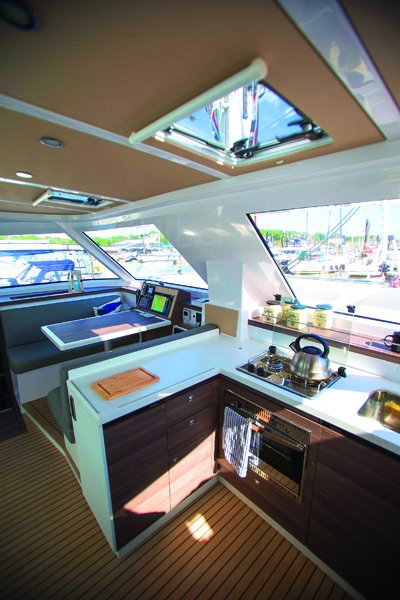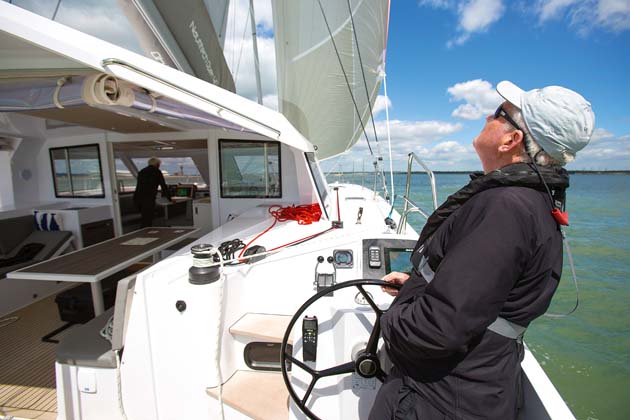The many qualities of the Nautitech Open 40 make a compelling case for choosing a catamaran over a monohull, says an impressed Matthew Sheahan
Nautitech Open 40 boat test – this cat will make you purr
Space, stability, performance and even safety, if you’re a monohull sailor you will be familiar with the key points of the arguments that multihull advocates present for having two hulls rather than one. In the main, their evidence is hard to refute.
For the same overall length catamarans do indeed have much more volume, especially below decks. They don’t heel like a monohull, something that regularly gains favour with many sailing families. And as for safety, the lack of a ballast keel makes it very unlikely that they will sink, even if capsized, something that no Nautitech cat has ever done in 20 years, we are told.
But when it comes to performance, the argument is less compelling, depending on which cat we’re talking about. See our feature on the pros and cons of multihulls.
If they’re not laden with cruising kit, or are one of the latest generation of multi-decked superstructures modelled on wedding cakes with a tiny token rig stuck on the top, they can in certain conditions outpace an equivalent length monohull.
Most of the time they’re better when reaching, but struggle to keep pace upwind and, for the sailing-minded buyer, this can be a compromise too far.
But with the Nautitech Open 40 catamaran you have to think again because this is a boat that challenges a number of common preconceptions.
At first glance she doesn’t stand out as anything out of the ordinary. Yet look a little closer and she’s far cleaner, simpler and, as a result, more attractive than many typical production cruising cats.
 For her length she has an impressively tall rig with a generous, modern fully battened square-top mainsail. Her cockpit accommodation is low and discreet; her configuration here suggests a well protected, secure area in which it is easy to move from hull to hull, or in and out of the main accommodation without ever feeling like you are out of touch.
For her length she has an impressively tall rig with a generous, modern fully battened square-top mainsail. Her cockpit accommodation is low and discreet; her configuration here suggests a well protected, secure area in which it is easy to move from hull to hull, or in and out of the main accommodation without ever feeling like you are out of touch.
There are, however, a few angles from which she looks dumpy and squared off and in places rather slab-sided. But in the main there are many good points in this new model and you can understand why she was the talk of the winter boat shows this year.
Surprising performance
In my opinion her strongest card is her performance under sail, not in the absolute speeds she achieves, but in the feel on the helm and the ease with which she can be handled.
With twin wheels set in each of the aft quarters you are not only enveloped in the security of a deep cockpit wall on the outer flanks, but have a superb view forward and through the wraparound windows in the coachroof. Indeed, the visibility to leeward is better when sailing upwind than aboard most monohulls with large overlapping headsails.
Both engine and sail controls are close to hand on either side with the additional benefit that the leads for the control lines have been well thought out and have far less friction than you would expect. This is particularly impressive given that most of the lines are led back to the cockpit discreetly and produce very little rope clutter.
This, combined with her well-balanced and light steering, makes her fun and rewarding to sail. During our sailing trials we got caught up in the opening stages of the upwind leg of a race in the Solent. Unable to resist lining up against a fleet of fully crewed monohulls, I was surprised at how well she coped.
What she lacked in pointing ability in the 12-16 knot sea breeze she made up for with a typical upwind pace of 6-7 knots. She only really lost out through the tacks when her size and windage slowed her through the breeze, and her self-tacking blade jib didn’t have the power to see her accelerate like the monohulls – hardly surprising. But for cruising, especially short-handed, she was sufficiently nimble and easy to manhandle.
Off the breeze her furling Code 0, flown off a short bowsprit – one of the factory-fitted options – provided plenty of power and her eagerness to sit at 8-9 knots on a reach was clear. Again, she remained light and easy on the helm.
 When it came to reefing or dropping the mainsail altogether, the stack pack system proved easy to get to via the steps near the mast foot that lead up onto the coachroof top. Because her superstructure doesn’t tower high above the water it’s easy to nip up onto the roof to tidy the sail away without feeling as if you are balancing on a moving high diving board.
When it came to reefing or dropping the mainsail altogether, the stack pack system proved easy to get to via the steps near the mast foot that lead up onto the coachroof top. Because her superstructure doesn’t tower high above the water it’s easy to nip up onto the roof to tidy the sail away without feeling as if you are balancing on a moving high diving board.
Under engine she’s a very manageable boat, and once again the helming position and the good all round visibility make her simple to manoeuvre in tight spaces. Fitted with the upgrade option of a pair of Yanmar 30hp engines (20hp is standard), along with two three-bladed Gori overdrive propellers, she motored at a brisk 7 knot pace with ease.
Otherwise her layout is pretty straightforward. There is plenty of space between the hulls to stow a dinghy on davits off the back of the cockpit, huge lockers forward to keep fenders and warps and plenty of additional stowage for extra sails such as the Code 0. All of which is very much in keeping with the typical layout of modern production cats.
Outdoor saloon
The arrangement of her main living accommodation is one of the few areas where she differs from the norm. Her saloon, for instance, is more outside than in. The patio-type doors and the main athwartships bulkhead run across the boat at approximately midships making the normal, inside living accommodation smaller than would be typical for this size of boat.
A modest table/navigation station is set to port and the galley is to starboard leaving the main saloon outside, abaft the patio doors where it shares the cockpit space.
While this might sound unusual – and less appealing for colder climates – the layout is certainly comfortable and practical and can be arranged to provide more shelter if required with the awning panels that clip into the underside of the coachroof and the cockpit coamings.
Apart from making the outdoor saloon a more pleasant place to sit while sailing or at anchor, the logic behind the configuration also stems from looking at how people actually use their boats. If it’s warm enough to be aboard that’s fine, but if it’s too cold the pub or a restaurant is a popular option.
The Nautitech comes in either a three or four cabin configuration, the former aimed at an owner’s layout with a spacious heads and shower area in the forward end of the port hull where a cabin would be in the four-cabin version. Both layouts have the provision for single skipper/crew berths in the bows.
 Styling is clean, modern and simple, and while she’s clearly a production boat the standard of build and finish are both good. She’s a SCRIMP-infused construction with a foam sandwich hull in which all the structural members are laminated in place.
Styling is clean, modern and simple, and while she’s clearly a production boat the standard of build and finish are both good. She’s a SCRIMP-infused construction with a foam sandwich hull in which all the structural members are laminated in place.
There are a couple of areas that may raise an eyebrow or two. The first is her builder, Bavaria. If you didn’t know before you started looking over her you’d be hard pressed to guess. So why would Bavaria want to build multihulls?
The answer lies in their desire to expand in the charter market, which they believe now means having a range of multihulls. So, instead of developing a range from scratch, Bavaria chose to buy into the market with the acquisition of Nautitech in 2014 and keep the production outfit in Rochefort, near La Rochelle.
The transaction has been of benefit to both sides after Bavaria brought its expertise in joiner work to Nautitech and raised the game for the French builders. This catamaran has also been designed as a powerboat. Seeing an identical looking boat passing at twice the speed with no rig and the crew sitting on the coachroof cum flybridge is bound to take the owners of the sailing version by surprise.
 Specifications
Specifications
LOA 11.98m/39ft 4in
LWL 11.94m/39ft 2in
Beam 6.91m/22ft 8in
Draught 1.35m/4ft 5in
Displacement 7,800kg/17,196lb
Engine 2 x Yanmar 20hp
Fuel 2 x 215lt/2 x 47gal
Water 2 x 215lt/2 x 47gal
Sail area:
Jib 28m2/301ft2
Mainsail 678ft2/63m2
Code 0 44m2/473ft2
Sail area:disp 23.5
Disp:LWL 128
Price ex VAT £291,600
Designed by Marc Lombard
Built by Nautitech Catamarans
Marketed in UK by www.keyyachting.com
Conclusion
As is so often the case, once you start sketching out the ideal wishlist for a good, practical family cruiser the sum of the parts can easily point to a catamaran. Yet no matter how compelling the advantages of space and comfort are, factors such as performance and the practicality of berthing, especially in the UK, can count heavily against making a shift to two hulls.
But the Nautitech Open 40 goes a long way to addressing at least one of these issues. She really is a fun and rewarding cruiser to sail, especially as you don’t feel as if you’re perched high above the water and forced to sail from the leeward side on one tack at the only wheel on the boat.
She lends herself well to short-handed sailing thanks to a simple, but intelligent cockpit layout. And when it comes to berthing, at just 40ft LOA she’s sufficiently modest in length and beam to slip into most marinas and harbours.
Her price tag of £291,600 ex VAT will make her feel considerably bigger than a typical 40ft monohull, but then that is because she is, especially below decks.
So, though at first glance you might think she’s just another production cat, the reality is the Nautitech Open 40 is quite different. I was impressed.








